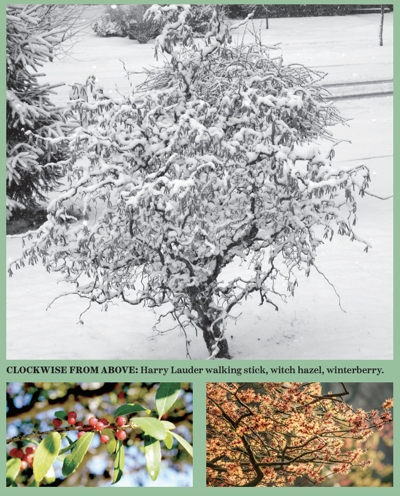Fall is quickly fading into winter in East Central Illinois, and with it, so are most gardens. However, while flowers die and trees and shrubs often lose their leaves, it is still possible to have some striking beauty on those days when the clouds hang low and the sun is on vacation in Australia.
John Wisegarver, garden center manager at Prairie Gardens in Champaign, offers some advice on how to enliven a drab winter yard.
“Some people want to have a tidy garden over the winter, and they want to go and cut everything back,” John says, but he suggests rethinking wholesale removal of flowers and other plants in the fall. “You want to consider keeping some of your perennials intact: ornamental grasses, coneflowers, sedums. Even though they’re brown, they have a neat structure and they’re also essential for birds. They make a nice habitat and they look pretty with snow on them.”
Besides being good habitats for birds, these plants also create vertical interest in a yard that might otherwise be flat and lifeless if everything is cut back. Some shrubs and trees also have visually striking details, such as colorful stems or berries or interesting texture or bark.
Some of John’s favorites that do well in Midwestern winters include winterberry, red twig dogwood, paperbark maple, river birch, witch hazel and Harry Lauder walking stick.
John’s “number one” suggestion is winterberry, a bush with beautiful green leaves in the spring, white flowers early in the summer and bright red clusters of berries in fall and winter.
“One of my second favorites is red twig dogwood, which is a shrub,” he says. “It has green leaves over the spring and summer, but then in winter, the stems become much more vibrant – blood red or burgundy red.”
Trees with unique textural features include paperbark maples and river birches, which have exfoliating bark, and Japanese maples, which have interesting bark colors, according to John.
If you want to be the first in your neighborhood with flowers on your shrubs, then witch hazel is the one for you, since they bloom as early as February. Last but not least, Harry Lauder walking sticks also make for an interesting addition because of their “gnarly, twisted stems.”
Though it’s generally too late to do much planting by the time midNovember rolls around, John says it’s not too early to start planning for next year. The winter months are ideal for seeing how various plants look when it’s cold and dreary outside.
Take a stroll through neighborhoods and parks and photograph plants that strike your fancy. Once you have some ideas, do your research, he says. Look up plants that interest you or talk to your local nursery employees to see if the plants you like will be a good fit for your yard and to see how they will look during different seasons.
If you do your homework now, you’ll be ready to start planting next spring. And when winter comes back around, you’ll have something to look forward to when you look out your window.


